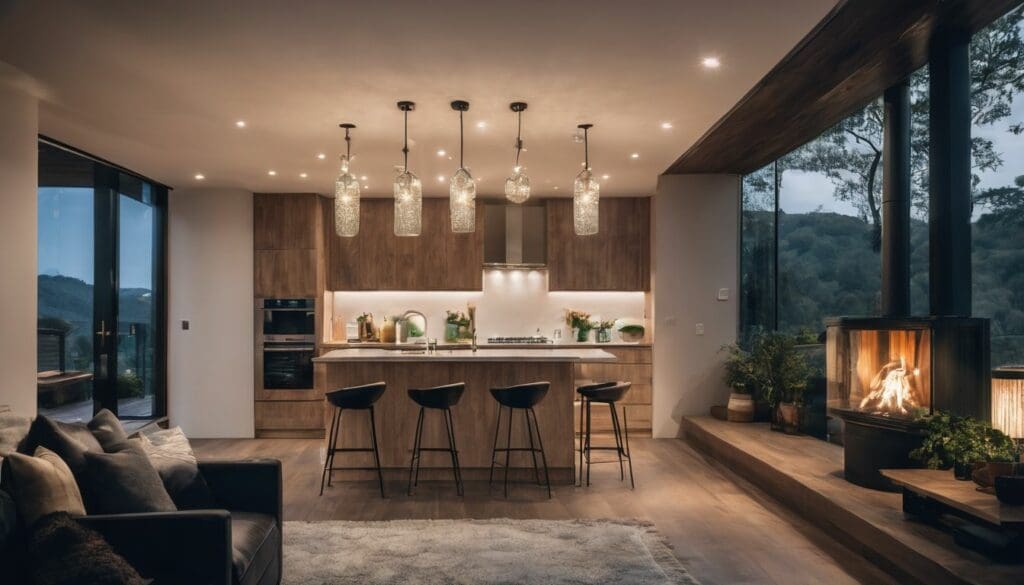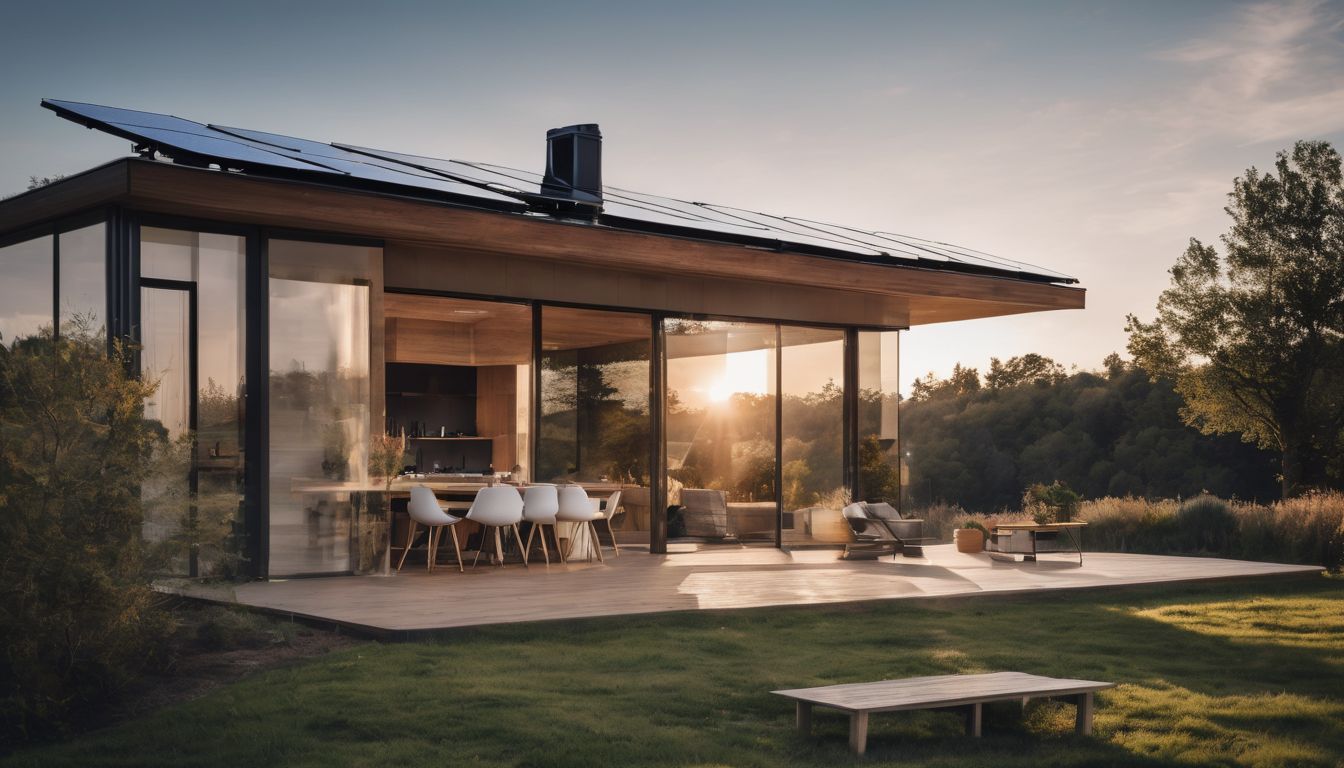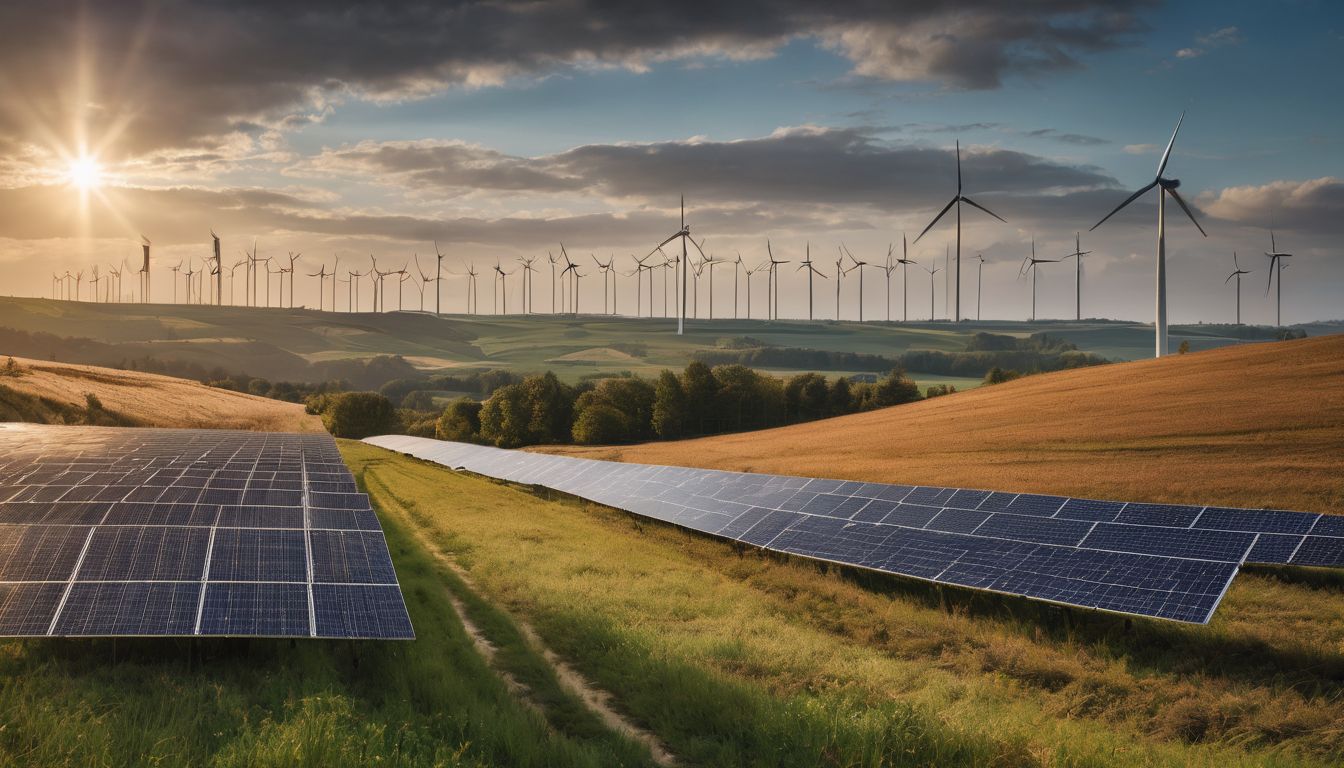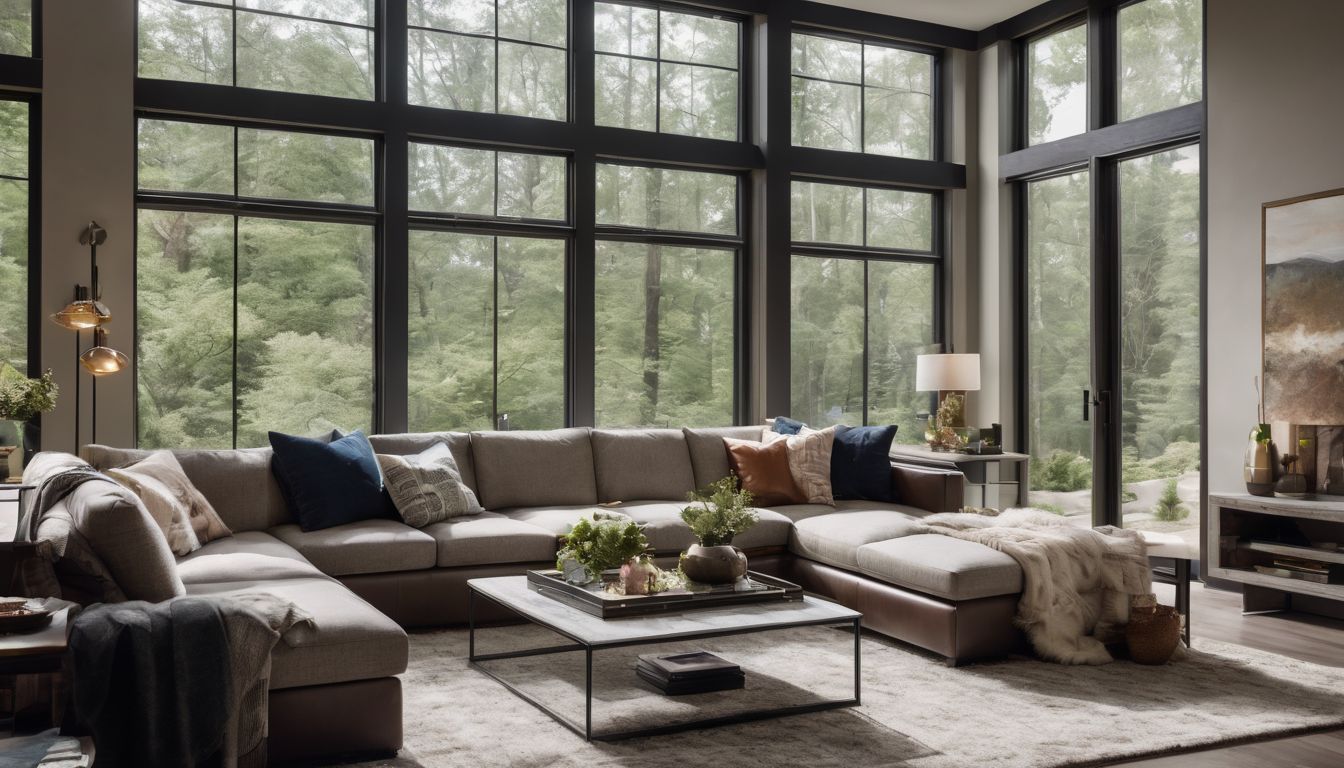Facing high energy bills can be a real worry for many of us. LED lighting uses up to 90% less energy compared to traditional bulbs. This article will explore how switching to LEDs not only cuts costs but also benefits the environment.
Keep reading – it’s brighter than you think!
Key Takeaways
- LED lights use up to 90% less energy than traditional bulbs, dramatically cutting electricity costs and benefiting the environment.
- Due to their long lifespan, LEDs reduce the need for frequent bulb replacements, which lowers waste and contributes to sustainability.
- With no toxic materials or emissions of heat and UV radiation, LED lighting is a safer choice that minimises environmental impact.
- The adaptability of LEDs means they can operate in extreme conditions and offer design flexibility with dimming capabilities as well as instant lighting.
- LED bulbs are compatible with low – voltage systems which allows them to easily integrate with renewable energy sources for an even lower environmental footprint.
What is LED Lighting?
LED lighting, or light-emitting diode lighting, is a type of energy-efficient lighting that uses a semiconductor to produce light. It works by converting electrical energy into light through the movement of electrons in the semiconductor material.
How do LEDs work?
LEDs, or Light Emitting Diodes, transform electricity into light without wasting energy on heat. This process, known as electroluminescence, involves electrons passing through a semiconductor material.
As they move, they emit photons—the basic units of light. The materials used in LEDs are crafted to allow for specific colours and brightness levels.
Eco-friendly lighting options like LEDs preserve energy by converting over 80% of the electrical power they receive directly into light output. That’s drastically more efficient than traditional bulbs which release most of their energy as heat.
With reduced carbon emissions and long-lasting performance, these low-energy consumption lights help conserve resources and cut down electricity costs for consumers. Moving on from how they operate internally lets us explore the myriad advantages that make LED lighting a top choice environmentally conscious individuals often prefer.
Advantages of LED Lighting
LED lighting offers numerous advantages, such as energy efficiency, improved environmental performance, design flexibility, and instant lighting capabilities. To learn more about how LED lighting can benefit you and the environment, keep reading!
Energy efficiency
LED lighting is highly energy efficient, consuming significantly less power than traditional light bulbs. This efficiency translates to reduced electricity costs, making it a cost-effective and environmentally friendly lighting option.
LED bulbs also last much longer than incandescent or fluorescent lamps, reducing the frequency of replacements and contributing to lower environmental impact. With low carbon emissions and reduced heat emission, LED lighting is proving to be an ecologically sound choice for those seeking sustainable and energy-efficient lighting solutions.
By using LED lights, you can benefit from the long-lasting nature of these bulbs while supporting conservation efforts with their low energy consumption and eco-friendly design. These features make LED lighting an effective way to reduce your carbon footprint while saving on electricity costs.
Improved environmental performance
LED lighting offers improved environmental performance compared to traditional lighting options. LED lights consume significantly less energy, making them an eco-friendly choice for reducing carbon emissions and overall energy consumption.
Their long lifespan also means fewer light bulbs end up in landfills, resulting in reduced waste and a lower impact on the environment. Additionally, LED lights contain no toxic materials, contributing to a cleaner and safer ecological footprint.
Furthermore, the ability of LEDs to operate without emitting heat or UV radiation reduces their environmental impact while enhancing safety. The design flexibility of LED lighting allows for efficient use of energy and resources while providing environmentally friendly lighting solutions that align with sustainable practices.
The ability to operate in extreme temperatures
LED lighting is capable of operating in extreme temperatures, making it a reliable choice for various environmental conditions. This feature makes LED lights suitable for outdoor settings, such as car parks, streets, and industrial spaces that may experience fluctuations in temperature.
The ability to withstand extreme temperatures also ensures consistent performance and durability, which are essential factors for environmentally friendly and energy-efficient lighting solutions.
Furthermore, the adaptability of LED lighting in extreme temperatures supports sustainable energy usage without sacrificing functionality or reliability. As a result, LEDs offer an eco-friendly and cost-effective solution for environments with varying climate conditions while reducing carbon emissions associated with traditional lighting technologies.
No heat or UV emissions
LED lighting produces no heat or UV emissions, making it an ideal choice for environmentally conscious individuals. This feature ensures that LED lights are safe to use in various settings, including museums, galleries, and other spaces where heat and UV radiation can cause damage to sensitive materials.
Additionally, the absence of heat emissions contributes to lower cooling costs in commercial and residential buildings. LED lighting’s ability to provide bright illumination without generating excess heat or harmful UV rays makes it a sustainable and energy-efficient option for eco-conscious consumers.
Moreover, the lack of heat or UV emissions from LED lighting also minimises the risk of fire hazards and potential harm to human health. The focus on reducing environmental impact through energy-saving technology such as LED lighting aligns with the goals of conservationists and those committed to sustainability efforts worldwide.
Design flexibility
LED lighting provides a high level of design flexibility, allowing for the creation of customised and innovative lighting solutions. With the ability to be easily dimmed, combined with other technologies for colour mixing and dynamic control, LED lighting offers endless possibilities for creating unique ambiances while reducing energy consumption.
The adaptability and versatility of LED fixtures also pave the way for creative architectural designs that seamlessly integrate lighting into spaces, enhancing aesthetic appeal while staying environmentally friendly.
Moreover, LED lights come in a variety of shapes and sizes, offering versatile options to fit different applications. This enables eco-conscious individuals to utilise energy-efficient bulbs in an array of environments without sacrificing style or functionality.
Instant lighting and ability to withstand frequent switching
LED lighting provides instant illumination as soon as they are switched on, making them ideal for areas where immediate light is required. This feature not only enhances safety but also helps to save energy by avoiding the need to keep lights running when not in use.
Additionally, LED lighting can withstand frequent switching without affecting their lifespan or performance, making them a durable and long-lasting lighting solution that supports energy conservation and environmental sustainability.
The ability of LED lighting to instantly provide bright light upon being turned on makes it an efficient and eco-friendly choice for those looking to reduce energy consumption and support sustainable lighting options.
Benefits of LED Lighting
LED Lighting offers a long lifespan, low voltage operation, and dimming capabilities. It also provides directionality and has a low environmental impact.
Long lifespan
LED lighting boasts an impressive long lifespan, lasting up to 25 times longer than traditional incandescent lighting. This extended longevity not only reduces the frequency of replacement but also minimises waste, making LED lights a sustainable choice for environmentally conscious individuals seeking low maintenance and durable lighting solutions.
With their prolonged operational lifespan, LED lights contribute to energy conservation efforts and reduce the need for frequent bulb replacements, aligning with eco-friendly and cost-effective lighting options.
Low voltage operation
LED lighting operates at low voltage, making it highly efficient and safe. This means that LED bulbs can be powered by low-voltage electrical systems, reducing the risk of electric shock and fire hazards.
Furthermore, this low voltage operation also allows for easy integration with renewable energy sources such as solar panels and wind turbines, contributing to a more sustainable and eco-friendly lighting solution for environmentally conscious individuals.
Moving on to “Dimming capabilities”..
Dimming capabilities
Transitioning from the low voltage operation of LED lighting, it is important to note that these energy-efficient bulbs also come with dimming capabilities. This feature allows users to adjust the brightness levels according to their needs and preferences, offering flexibility and further energy savings when full illumination is not required.
Furthermore, dimming capabilities extend the lifespan of LED bulbs, making them even more cost-effective and environmentally friendly.
As an eco-friendly lighting option, the ability to dim LED lights not only provides customisable lighting solutions but also contributes to reducing carbon emissions and conserving energy resources.
Directionality
LED lighting offers the advantage of directionality, directing light exactly where it’s needed. This precision helps reduce wasted light and minimises environmental impact by conserving energy and resources.
Directional LED lighting also provides better visibility and illumination, making it an ideal choice for environmentally conscious individuals seeking efficient and eco-friendly lighting solutions.
With LED technology, users can efficiently direct light to specific areas without wasting energy on unnecessary spaces or creating light pollution-inducing glare. This targeted approach enables greater control over energy consumption while contributing to a more sustainable environment.
Low environmental impact
LED lighting provides a low environmental impact, reducing carbon emissions and energy consumption. This eco-friendly lighting option helps in conserving energy and supporting sustainable living.
LED bulbs have long lifespans and produce minimal heat emission, making them an environmentally responsible choice for home or commercial use.
Disadvantages and Challenges of LED Lighting
System efficiency, reliability, and lighting quality are some of the challenges associated with LED lighting. However, ongoing advancements in technology are addressing these issues to improve overall performance.
System efficiency
LED lighting systems are known for their high efficiency, consuming less energy than traditional lighting options. This results in lower electricity bills and reduced carbon emissions.
LED lights convert almost all the energy they consume directly into light, minimising wasted energy as heat. Additionally, their long lifespan reduces the frequency of replacements, further lowering environmental impact and contributing to cost savings.
Efficiency also extends to the ability of LED lighting to operate at full brightness immediately upon switch-on, eliminating warm-up time and reducing unnecessary energy consumption.
System reliability
LED lighting’s system reliability is a crucial factor to consider. Ensuring that LED fixtures and components are well-designed and constructed improves the overall performance and longevity of the lighting system.
It also reduces the likelihood of failure, contributing to cost savings, environmental impact reduction, and long-term energy efficiency.
One significant aspect affecting system reliability is the quality of LED drivers and thermal management systems. Proper installation, maintenance, and compatible controls also play essential roles in sustaining reliable operation.
Lighting quality
LED lighting is renowned for its high-quality illumination, providing bright and consistent light output. The directional nature of LED bulbs ensures that the light is focused where it’s needed, minimising wasted light and optimising energy efficiency.
This results in crisp, clear lighting without flickering or glare, enhancing visual comfort and reducing eye strain. LED technology also offers excellent colour rendering capabilities, meaning that the colours of objects are accurately represented under the light.
All these factors contribute to creating a superior lighting experience while minimising environmental impact.
Conclusion
In conclusion, LED lighting offers numerous advantages for saving energy. It provides high energy efficiency and long-lasting bulbs while minimising environmental impact. With its low energy consumption and reduced heat emission, LED lighting is an eco-friendly and cost-effective choice for environmentally conscious individuals seeking sustainable lighting options.
FAQs
1. Why are LED lights considered energy-efficient?
LED lights are energy-efficient because they use less power, which reduces carbon emissions and lowers your energy bills.
2. How do LED lights help the environment?
LED lighting has a reduced environmental impact, emitting less heat and using renewable energy sources to brighten our homes in an ecologically-friendly way.
3. Are LED bulbs really long-lasting?
Yes, LED bulbs last much longer than traditional ones, providing long-lasting lighting that saves you from frequently buying replacements.
4. Can switching to LED lighting save me money?
Switching to energy-saving technology like LED lights is cost-effective; they consume low energy and have fewer maintenance costs over time.
5. Is it true that LEDs offer more eco-friendly lighting options than other bulbs?
Absolutely! Eco-friendly LEDs provide green lighting by lowering the demand for electricity from polluting power plants and minimising waste with their longevity.





